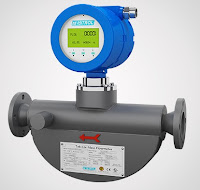 |
| Thermal Dispersion (left) vs. Coriolis (right) Flow Technology (click for larger view) |
CORIOLIS FLOWMETER
A Coriolis mass flowmeter measures mass flow rate of the fluid with a U-shaped tube that deflects or vibrates as the fluid flows through it. The operation of this type of mass flow meter is based on the conservation of angular momentum as it applies to the Coriolis acceleration of a fluid. Fluid flows through the oscillating tubes, twisting them slightly in proportion to the mass flow of the fluid and its inertia. Sensors are fixed at the inlet and outlet junctures of the tube, at equal distances from the central fixed point. When there is no fluid flowing through the tube, the amplitude is constant and the sensors at either end are in phase with one another. |
| Coriolis flowmeter (Tektrol) |
THERMAL DISPERSION FLOWMETER
 |
| Thermal flowmeter (Tektrol) |
The Constant Current Method maintains a constant differential temperature and the current required to maintain the differential is used as the basis for determining the flow. The greater the mass flow rate, the greater is the cooling effect and the more current needed to maintain the same differential temperate.
The Constant Temperature Differential Method measures the differential temperature between sensors. A temperature difference between the two sensors is an indication of the mass flow rate of the fluid. The greater the mass flow rate, the smaller the temperature difference.
For any questions about measuring process flow, contact Hile Controls of Alabama by visiting https://hilealabama.com or by calling 800-536-0269.

